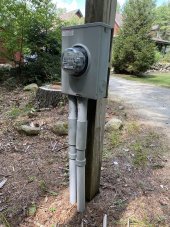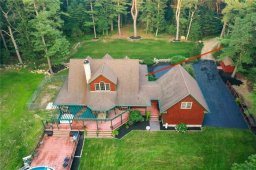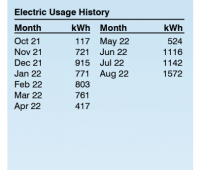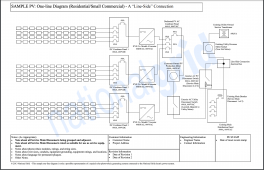I've been browsing the forums for the last few months and watching/following multiple YouTubers. We moved into a house with some acreage last fall and have been interested in installing a ground array to help offset some of our energy costs. It first sparked when we got our first true Winter electric bill (~$.22/kwh). It's our first house with a hot tub so we learned quickly that our biggest energy hog during Winter is the hot tub. We use No.2 Heating Fuel with a Boiler for heat/hot water. During the summer, we've found the pool pump and AC units (3 Central Air Systems) are our biggest users for these months.
We've had a few solar installers come by and give us some quotes. All of them were between $40-60K using similar designs. I wanted to use a Sol-Ark 12K as the inverter with some LiFePO4 storage (most included Kilovault). I wanted about 13 kwh worth of panels in any configuration that made sense for the ground array. Unfortunately, this is where the process stopped. I found out the Grid Provider limits the amount of Solar you can install for Grid-tie systems. We are not allowed to install more than 100% of annual usage based on the past 3 years. We had only been in the house for a few months and didn't have any historical usage. The Grid Provider wouldn't provide us the previous homeowner's usage either citing "personal information." Luckily, one of the solar companies managed to pull the historical data and shared it with me. Previous homeowners only used 9,000 kwh a year (avg 3 years). Therefore, the grid-tie system we could install would be lower than what I wanted to install.
With the cost of the quotes, I decided that maybe I could install the system and save some money. I'd be willing to install the lower amount of solar array with the thought process of expanding later on (as suggested by one of the installers). So far, our first year is projected to exceed the previous homeowners usage, but not too much. This is where I started to plan the system. At first, I was going to use Sol-Ark 12K with a Critical Load Panel. I needed a subpanel installed anyways due to no room in main panel. (I've installed said subpanel and moved all critical loads to it). Then the Sol-Ark 15K was announced and would be a great solution as it's a nice AIO and the 200A pass thru was a huge selling point to me. Obviously, the 15K would be oversized, but then I could have larger battery bank for the future.
I started the wire diagram and reading up on the requirements the grid-provider required for grid-tie systems. This is where I'm stuck at how to design the system with either the 12K or 15K unit. The issue I have is the power meter is not installed at the house. It's installed on a pedestal about 120 ft away. Load center is installed in the basement and have no good way to wire in an external disconnect. I have to replace the pedestal (wood rotted) and asked the electrician about installing a main disconnect at the pedestal. He basically said I would have to pull a whole new cable from the meter base to the house (needing 4 conductors vs. 3 that I have now). Also main panel will have to be rewired as a sub panel instead of a main panel (just more labor). I was hoping the main disconnect install would be acceptable by the grid provider as my knife disconnect between the meter and main panel since it's required per their design documents. I'm getting a couple other quotes to replace the wood at the pedestal and will ask the other electricians about the disconnect. If it requires pulling a whole new cable in order to install the disconnect, then I think it'll be a no go for solar.
Details:
200A main panel (bus is 200 amp); so was looking at line-side tap, but may not be acceptable by grid provider - they weren't very clear
Exterior Disconnect Required
Interior Disconnect Required - That will be easy to add in
PV Production Meter - Everyone that I've seen has a production meter on exterior side of house. Documents make it sound like they have a bi directional meter, but new installs (within last week) have PV meter. Not sure if it can be installed in basement as I can not install on side of house.
Inverter was going to be installed in basement next to critical load panel and batteries. Solar Array was going to be installed on North side of the house with array facing South. Conduit was going to be installed between array and inverter (South side of house where load center is).
So my questions are; can you see any other way to install a grid-tie system with some of the NEC 2020 requirements that are imposed without pull whole new cable from meter to house or relocating meter to house (bay windows are installed where underground pipes comes up into basement to main panel).
Has anyone installed solar (recently) with a pedestal installed or meter not attached to structure?
I realize some answers can only be answered by the utility provider, but they won't answer questions from homeowner install without submitting application. Figured I could do some ground work and propose alternative solutions if it meets NEC requirements. I've thought about not attaching into the Grid, but don't think my loads will use all power generated during the summer. Main panel has more demand (hot tub, two AC condensers (2 and 2.5 ton units), but don't think I can afford to run whole home with solar/battery without giving up some of the big loads.
Note: The grid provider does pay $.27/kwh that I produce, so it is a factor to install with grid-tie.
Any help will be greatly appreciated!




(RI Energy Sample for Residential Installs; thus what I'm working with as a sample)

I do have line diagram I drew up, but with the extra items for NEC, I just don't know where to install it.
Thanks in advance!
We've had a few solar installers come by and give us some quotes. All of them were between $40-60K using similar designs. I wanted to use a Sol-Ark 12K as the inverter with some LiFePO4 storage (most included Kilovault). I wanted about 13 kwh worth of panels in any configuration that made sense for the ground array. Unfortunately, this is where the process stopped. I found out the Grid Provider limits the amount of Solar you can install for Grid-tie systems. We are not allowed to install more than 100% of annual usage based on the past 3 years. We had only been in the house for a few months and didn't have any historical usage. The Grid Provider wouldn't provide us the previous homeowner's usage either citing "personal information." Luckily, one of the solar companies managed to pull the historical data and shared it with me. Previous homeowners only used 9,000 kwh a year (avg 3 years). Therefore, the grid-tie system we could install would be lower than what I wanted to install.
With the cost of the quotes, I decided that maybe I could install the system and save some money. I'd be willing to install the lower amount of solar array with the thought process of expanding later on (as suggested by one of the installers). So far, our first year is projected to exceed the previous homeowners usage, but not too much. This is where I started to plan the system. At first, I was going to use Sol-Ark 12K with a Critical Load Panel. I needed a subpanel installed anyways due to no room in main panel. (I've installed said subpanel and moved all critical loads to it). Then the Sol-Ark 15K was announced and would be a great solution as it's a nice AIO and the 200A pass thru was a huge selling point to me. Obviously, the 15K would be oversized, but then I could have larger battery bank for the future.
I started the wire diagram and reading up on the requirements the grid-provider required for grid-tie systems. This is where I'm stuck at how to design the system with either the 12K or 15K unit. The issue I have is the power meter is not installed at the house. It's installed on a pedestal about 120 ft away. Load center is installed in the basement and have no good way to wire in an external disconnect. I have to replace the pedestal (wood rotted) and asked the electrician about installing a main disconnect at the pedestal. He basically said I would have to pull a whole new cable from the meter base to the house (needing 4 conductors vs. 3 that I have now). Also main panel will have to be rewired as a sub panel instead of a main panel (just more labor). I was hoping the main disconnect install would be acceptable by the grid provider as my knife disconnect between the meter and main panel since it's required per their design documents. I'm getting a couple other quotes to replace the wood at the pedestal and will ask the other electricians about the disconnect. If it requires pulling a whole new cable in order to install the disconnect, then I think it'll be a no go for solar.
Details:
200A main panel (bus is 200 amp); so was looking at line-side tap, but may not be acceptable by grid provider - they weren't very clear
Exterior Disconnect Required
Interior Disconnect Required - That will be easy to add in
PV Production Meter - Everyone that I've seen has a production meter on exterior side of house. Documents make it sound like they have a bi directional meter, but new installs (within last week) have PV meter. Not sure if it can be installed in basement as I can not install on side of house.
Inverter was going to be installed in basement next to critical load panel and batteries. Solar Array was going to be installed on North side of the house with array facing South. Conduit was going to be installed between array and inverter (South side of house where load center is).
So my questions are; can you see any other way to install a grid-tie system with some of the NEC 2020 requirements that are imposed without pull whole new cable from meter to house or relocating meter to house (bay windows are installed where underground pipes comes up into basement to main panel).
Has anyone installed solar (recently) with a pedestal installed or meter not attached to structure?
I realize some answers can only be answered by the utility provider, but they won't answer questions from homeowner install without submitting application. Figured I could do some ground work and propose alternative solutions if it meets NEC requirements. I've thought about not attaching into the Grid, but don't think my loads will use all power generated during the summer. Main panel has more demand (hot tub, two AC condensers (2 and 2.5 ton units), but don't think I can afford to run whole home with solar/battery without giving up some of the big loads.
Note: The grid provider does pay $.27/kwh that I produce, so it is a factor to install with grid-tie.
Any help will be greatly appreciated!




(RI Energy Sample for Residential Installs; thus what I'm working with as a sample)

I do have line diagram I drew up, but with the extra items for NEC, I just don't know where to install it.
Thanks in advance!


